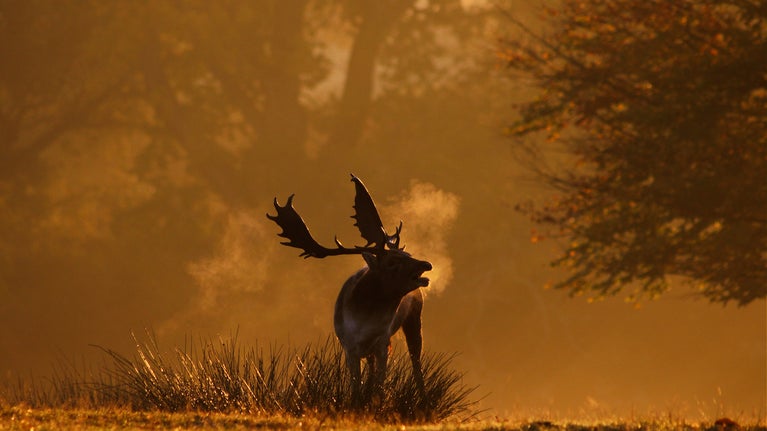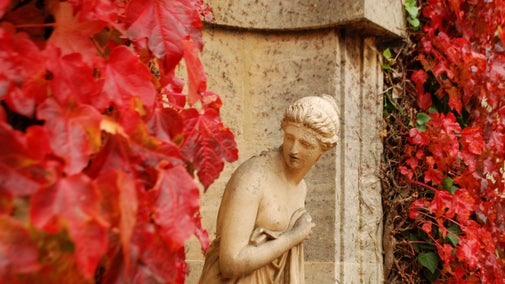
Discover more at Belton
Find out everything you need to know about visiting Belton, including how to get here, things to see and do on your visit, and more.

With 1,300 acres of parkland surrounding Belton House, there's plenty to explore beyond the garden, including wildlife-rich open grassland, the River Witham and ancient woodland. The deer can be easily seen on walks across the parkland, with plenty of opportunity for some great photos.
Discover the resident Woodpeckers that call Belton home on our Woodpecker trail through the parkland. Enjoy a wander through the parkland on this trail and see if you can see or hear our feathered friends, while learning more about them.
Join the Ranger Team on this guided walk through the parkland and discover how they care for the herd, while keeping an eye out for any signs of the autumn rut. Don't forget to bring your camera!
Running between 16 - 22 October. Advance booking is required.
Autumn is a great time of year to spot wildlife, from deer and fungi to birds and bats. With woodland and sweeping countryside to explore, take a closer look at the autumn nature at Belton.
Belton is an interesting place for migratory birds; as the weather turns colder we'll welcome back the redwings and fieldfares. They can be seen in flocks across the parkland, distinguishable from our native thrushes by their presence out on the open ground, and their distinctive red 'armpits'.
Autumn is a transitionary time, and our convenient location makes an ideal stopover for a long journey. It's possible to see all sorts of avian visitors, if you happen to be in the right place at the right time.

With the drawing-in of the evenings, the chances of spotting some of our own species become far greater. While our resident little owls are active throughout the day, our tawny and barn owls are mainly crepuscular (most active at dawn and dusk).
Tawny owls are owls of woodland areas, so keep a look out around Old Wood and the Bellmount Plantations, whereas barn owls are creatures of open grassland so may be seen hunting out over the parkland or along the river corridor in search of field and bank voles.
Our herd of fallow deer have spent the long, hot summer looking after their fawns and growing some impressive sets of antlers. Autumn is show-time for the master bucks, who will set up rutting stands in favourite spots and try and attract as many does as possible.

The rut is a really special time of year in the park - the biggest males will face off with each other by parallel walking, bellowing, and finally locking antlers to establish seniority over other males.
For the months of October and November they have one thing, and one thing only, on their minds; covering as many female deer (does) as possible – even to the exclusion of eating.
They will enter the hard winter months exhausted and having lost all physical condition, but their efforts will see the continuation of the herd with the birth of a new generation of fawns early next summer.
Along the river the butterflies and dragonflies will fade fast as the temperature cools, but our otters and water vole will remain active (if elusive) throughout the autumn.

As the vegetation begins to die back and the ground becomes wetter the signs and tracks from these secretive animals become easier to spot – look out for the five-toed print of an otter in the wet mud, or the neatly nibbled-off stems of reeds near the river’s edge that signifies the presence of a hungry water vole.
The still and silent herons can still be seen watching patiently for a passing snack, stood statue-like in the margins of river, ponds, and pools across the park; likewise their smaller, whiter cousins – the little egrets - both visiting from the heronry over on the golf course.
Autumn is the time when bats in the park will start turning their minds towards their hibernation roosts.
Bats will mate during the autumn and sometimes into the winter, but, due to a process known as delayed implantation (or embryonic diapause), the females don’t become pregnant until the spring.
Throughout the coldest months these tiny creatures will enter a state of hibernation or prolonged torpor in which their body temperature is lowered and their metabolic rate slows dramatically – this allows them to survive the harshest weather on their own body fat rather than wasting energy foraging for scarce food sources.
In order to have the best chances of surviving the hibernation period, they will spend the autumn months feeding as much as possible to build up reserves for the months ahead, before finally seeking out a roost of suitable temperature and stability where they will be safe until the temperatures rise once more.

Find out everything you need to know about visiting Belton, including how to get here, things to see and do on your visit, and more.

Belton is a three pawprint rated place and offers plenty of opportunities for bounding, jumping and sniffing for dogs. With 1,300 acres to explore, come and join us for a wander with your four-legged friend.

Explore the gardens at Belton, including the Italian Garden, a Conservatory and a Dutch Garden with formal bedding schemes. Whatever time of year you visit, the shifting seasons provide a great variety of colour and wildlife to see.

Packed full of treasures, discover a mansion bursting with history. Belton's collection tells a story rich in global history and our future work will focus on bringing those stories to life.

Explore our fun family day out ideas, including our indoor play area and outdoor adventure playground. Make the most of your day out with the kids at Belton this October Half Term.

The Belton Estate played a significant supporting role in the First World War. Find out about the small town, with hospital and cinema, built for 20,000 men of Kitchener’s Army.

Explore some of the finest landscapes in our care on coastal paths, accessible trails, woodland walks and everything in between. Find the best places to walk near you.

Plan a visit to one of the special countryside places in our care and discover the benefits of being in the great outdoors. Pack your walking boots and get ready to explore woodlands, valleys and rivers.